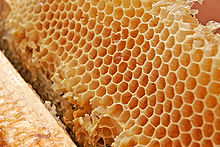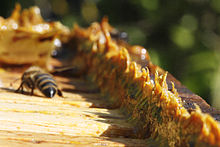Apitherapy
As apitherapy ( lat. Apis bee and Greek. Θεραπεία therapeia serving, and caring for the sick) is the medical use of bee products, mainly propolis , bee venom , honey called and the bees air, partly provided use of beeswax (see below) and the consumption of pollen and royal jelly counted as apitherapy.
History of apitherapy
In the past, apitherapy was more of a by-product of beekeeping and was mainly known among beekeepers. Today, especially in recent years, it has come more and more into the focus of research and could be of relevance in combating multi-resistant bacterial strains and wounds that are difficult to heal.
Apitherapy in Germany
Apitherapy was still largely unknown in Germany until 1986 when the Bamberg beekeeper Wilhelm Hemme came across the term "apitherapy" while studying the Apimondia reports (Apimondia is the World Bee Association) at the Stuttgart-Hohenheim bee institute. On October 17, 1986, he founded the German Apitherapy Association (DAB), an association of friends of apitherapy, whose first president was Hemme.
application areas
Propolis
Propolis is bactericidal and antiviral. The resin also puts a thin film over the treated area. There may be intolerances; Contact allergies can occur especially with frequent extensive contact.
Bee venom
The effectiveness in postulated areas of application such as multiple sclerosis or arthritic pain has not been proven.
honey
The apitherapeutic use of honey goes beyond taking it for sore throats ; For example, honey is applied externally locally (applied to the affected areas).
Honey contains germ-inhibiting substances called inhibins. Sterilized honey can be applied directly to open wounds and burns. It has a slightly acidic pH value and its high sugar content creates a strong osmotic pressure. In a pilot study, it was also effective against multi-resistant bacteria. In particular, the New Zealand manuka honey has been investigated and marketed as a therapeutic agent.
Overall, the current data does not allow any clear conclusions to be drawn about the therapeutic effectiveness of honey.
Stick air therapy
Bees keep their beehive clean. The air in the beehive smells pleasantly of propolis, pollen and honey. For asthma inhalation might Bee hive air have soothing effect. Individual reports are euphoric, but here too the data is so thin that it is not possible to make a general therapeutic statement.
literature
- The Swiss father bee . Vol. 4, 18th edition. Bern 1930
Web links
- German Apitherapy Association
- Austrian Society for Apitherapy
- Swiss Apitherapy Association
- Swiss Apitherapy Association - French-speaking Switzerland section
Individual evidence
- ↑ a b Natural antibiotic - How honey works against multi-resistant bacteria ( Memento from April 12, 2016 in the Internet Archive ), Deutsche Welle
- ↑ nursingtimes.net
- ↑ ebm.bmj.com ( Memento from July 8, 2012 in the web archive archive.today )
- ↑ ecam.oxfordjournals.org ( Memento of the original from September 18, 2009 in the Internet Archive ) Info: The archive link was inserted automatically and has not yet been checked. Please check the original and archive link according to the instructions and then remove this notice.
- ↑ dailyherald.com
- ↑ journalofwoundcare.com
- ↑ nzma.org.nz ( Memento of the original from June 24th, 2009 in the Internet Archive ) Info: The archive link was inserted automatically and has not yet been checked. Please check the original and archive link according to the instructions and then remove this notice.
- ↑ Dee A. Carter, Shona E. Blair, Nural N. Cokcetin, Daniel Bouzo, Peter Brooks: Therapeutic Manuka Honey: No Longer So Alternative . In: Frontiers in Microbiology . tape 7 , April 20, 2016, ISSN 1664-302X , doi : 10.3389 / fmicb.2016.00569 , PMID 27148246 , PMC 4837971 (free full text) - ( frontiersin.org [accessed February 5, 2020]).
- ^ AB Jull et al .: Honey as a topical treatment for wounds. In: Cochrane Database Syst , Rev. 2008 Oct 8, (4), CD005083, PMID 18843679
- ^ OA Moore et al .: Systematic review of the use of honey as a wound dressing. In: BMC Complement Altern Med. , 2001, 1, p. 2. Epub 2001 Jun 4, PMID 11405898
- ↑ Healing air from the beehive? Retrieved February 5, 2020 .


